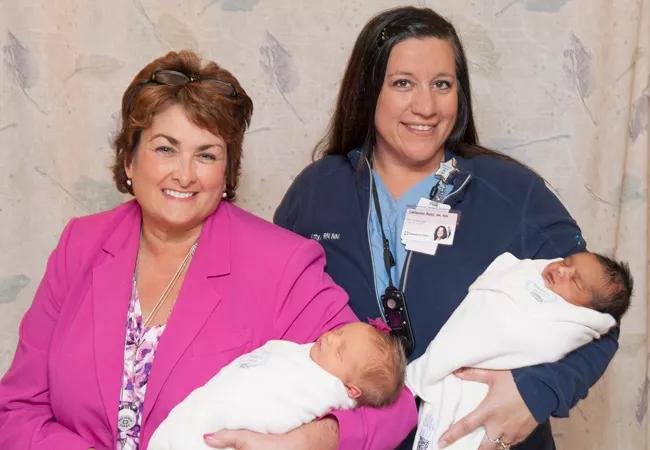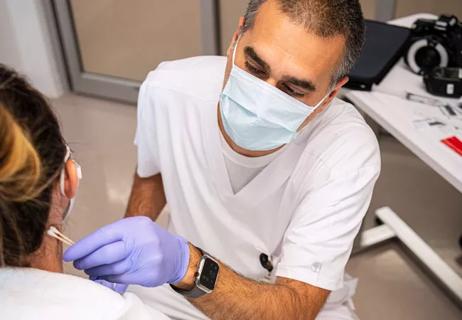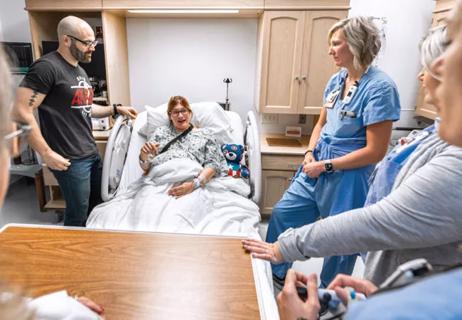Tackling the issue of high infant mortality rates

Cleveland Clinic obstetrics nurses have become part of a statewide effort to help more babies reach their first birthdays. With Ohio ranked 45th out of 50 in infant mortality, or death before age 1, the cause has become critical.*
Cleveland Clinic is a non-profit academic medical center. Advertising on our site helps support our mission. We do not endorse non-Cleveland Clinic products or services. Policy
In Cuyahoga County, the pocket of Northeast Ohio that surrounds Cleveland Clinic, the infant mortality rate is about 9 per 1,000 live births, says Kitty Russ, MSN, RN, MSHA. She manages the birthing center and high-risk obstetrics unit at Cleveland Clinic’s Fairview Hospital on the near west side of Cleveland.
“Today about one-fifth of 1,024 infant deaths each year are preventable,” says Russ. “Preventable deaths are sleep related [the leading cause of death for infants from one month to one year of age] or those caused by injury or homicide.” Other leading causes of infant mortality include premature birth and congenital malformations.
Inpatient nursing can have a big impact on sleep-related deaths, she notes. Sadly, in Ohio, there are more than three sleep-related infant deaths each week according to the Ohio Department of Health (ODH). The ODH lists the following as causes for sleep-related deaths: sudden infant death syndrome (SIDS), unintentional suffocation, positional asphyxia, overlay, and undetermined causes.
Russ and nurse leaders in Cleveland Clinic’s Women and Children’s Affinity Group are using multiple efforts to tackle this issue head-on.
Education is one of the first steps to impacting change, says Tina Di Fiore, MSN, APRN, CNP, NNP-BC, CNS, an advanced practice nurse at Cleveland Clinic’s Hillcrest Hospital, on the near east side of Cleveland. In June, Hillcrest hosted nurses from across Northeast Ohio for a “Safe Sleep” education program. As part of the event, nurses heard from health professionals and parents from the SIDS Network of Ohio collective who lost children to sleep-related causes. The event gave nurses a chance to review and discuss safe baby sleep practices with county experts.
“We learned that creating a safe sleep environment is all about a safe crib,” Di Fiore says. According to statewide Baby Safe Sleep Guidelines, “bare is best” and both Hillcrest and Fairview have set out to be good examples for new mothers.
Says Di Fiore at Hillcrest, “The hospital bassinet is often a parent’s first example of a baby’s sleep environment, and people learn more from our behavior than our words. So our team set out to have model in-room bassinets by avoiding the bulb syringe tucked into the corner and burp cloths draped over the sides, etc.”
Hillcrest also began conducting safe sleep audits. A secret observer checks about 40 newborn sleep environments each month, making note of what is in the crib, the baby’s sleep position and other details.
Fairview Hospital is approaching crib safety in another way. At the entrance of the hospital’s Mother-Baby Unit sits a traditional-size crib with nothing inside but a sheet-covered mattress and a life-size baby doll, says Joyce Arand, MS, RN, CNS, NEA-BC, director of Women’s and Children’s Services at Fairview and Lakewood hospitals. “We’ve been misled that every new baby needs bumper pads and other crib decorations,” she says. “But these are the things that could actually hurt an infant.”
Also this year, the group is raising funds to provide a safe sleep sack for every baby born at Fairview Hospital. Sleep sacks are like a onesie for infants to sleep in. “We not only have to convince the new mothers to create a safe sleep environment,” Arand says, “but we need to convince and show the grandmothers and aunts and other family members who care for newborns.”
Affinity group members are also looking at ways to engage the public in discussions. They are getting the message out at community outreach events and health and wellness fairs throughout the city. When affinity group members attend events, they feature a “bare naked” crib on display, and nurses are available to talk to attendees and provide educational materials.
As federal measures, such as the Healthy People 2020 initiative, begin to drive national change around infant mortality, Arand says the affinity group is talking to Cleveland Clinic’s Government Affairs Team about working with county and state officials to localize efforts. The group would like to urge Ohio lawmakers to follow other states in outlawing the sale of crib bumper pads.
The affinity group is encouraged by the new Ohio Infant Safe Sleep Law, which mandates that healthcare providers educate families about safe sleep practices. Healthcare professionals must ask families if they have a safe sleep environment for their newborn. If they do not have a safe crib or cannot afford to get one, healthcare professionals must refer the new mom/parents to a program that provides free cribs.
Russ is also a member of the Cleveland-Cuyahoga Partnership to Improve Birth Outcomes, which focuses on reducing infant mortality in the state of Ohio. She was also part of the Cuyahoga County Child Fatality Review Committee whose members drafted an addendum to the state legislation, which now makes fetal and infant mortality review part of the Child Fatality Review Bylaws in Cuyahoga County.
With a range of efforts in place to reduce infant mortality rates, the affinity group is beginning to measure its results. It is too early to cull large-scale data, Arand says, because statewide and national statistics are only available every few years. But anecdotally, public awareness is growing. “We’re making people in the government aware,” she says, “and we’re making community leaders aware.”
Micro-level results are already becoming available. The July safe sleep audit at Hillcrest Hospital showed that 100 percent of families received safe sleep education, Di Fiore says. And the crib checks revealed 50 percent compliance, up from 40 percent in May and 44 percent in June. “We are improving at a slow but steady pace,” Di Fiore says.
The affinity group’s key takeaway so far, Arand says, is that nurses in every role should support safe sleep and share the message with patients. “Every nurse, no matter their title, has the possibility to influence,” she says.
*In 2013, the rate was 1,600 preventable deaths. Numbers have improved due to state and healthcare efforts that were implemented.
Photo credit ©Russell Lee

Nurses play pivotal role in patients’ ability to recover in the comfort of their own homes

Advocating for patient safety is imperative in fast-paced surgical settings

Advice for those pursuing a WOC nursing career

Redesigned protocols enhance infection-prevention measures

Longevity in healthcare, personal experiences may provide caregivers with false sense of confidence

Specialized team prioritizes trauma-informed care and evidence collection

Collaborative approach leans on expertise of nurses

TeamBirth aims to improve outcomes by facilitating collaboration between patients and caregivers